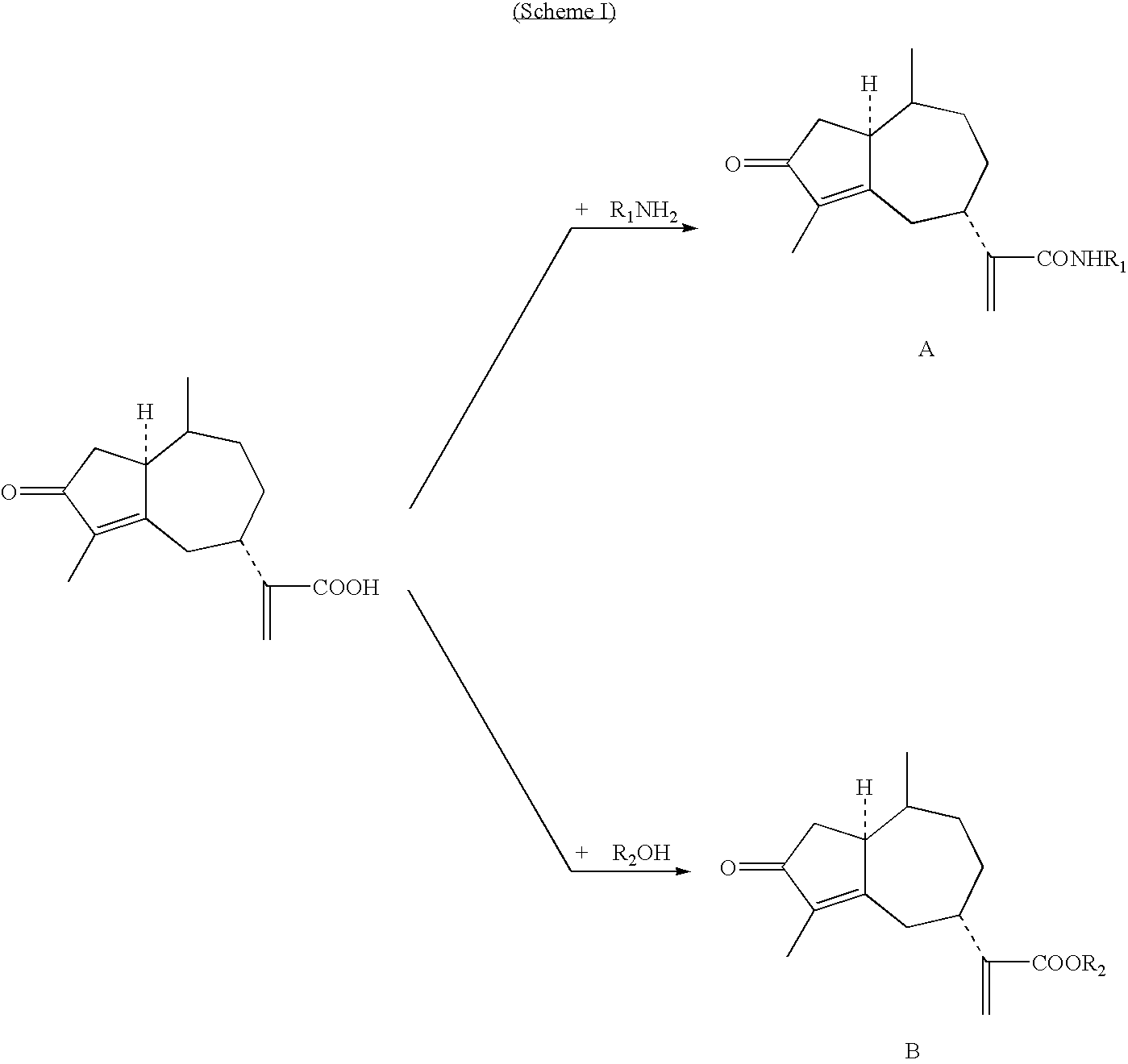Rupestonic acid derivatives and use thereof
- Summary
- Abstract
- Description
- Claims
- Application Information
AI Technical Summary
Benefits of technology
Problems solved by technology
Method used
Image
Examples
example 1
Preparation of Rupestonic Acid
[0070]Rupestonic acid was extracted by a conventional continuous extraction method. Five kilograms of ground Artemisia rupestric L. were used. The extraction was carried out with IL 95% Ethanol three (3) times, and the resultant extracts were combined. The combined extracts were concentrated into an extractum, which was further extracted with ethyl acetate several times. The ethyl acetate layers were combined, concentrated and separated through a silica gel column. The resultant raw rupestonic acid was re-crystallized to obtain the pure product.
[0071]Rupestonic acid: colorless column crystal, [a]D26+150 (c 0.176, CH3CH2OH), mp.132-134° C. IR (KBr) υ: 3230, 2970-2860, 1720, 1680, 1635, 1415, 1390, 1238, 958 cm−1;
[0072]1H NMR (600 MHz, CDCl3): 0.67 (d, J=7.2 Hz, 3H,CH3), 1.63 (m, 1H), 1.64 (m, 1H), 1.81 (m, 1H), 1.84 (m, 1H), 1.88 (m, 1H), 2.06 (m, 1H), 2.14 (m, 1H), 2.46 (m, 1H), 2.64 (m, 1H), 2.86 (m, 1H), 2.90 (m, 1H), 3.22 (m, 1H), 5.76 (s, 1H), 6.40 ...
example 2
[0077]Rupestonic acid was prepared according to Example 1.
[0078]Synthesis of B-type rupestonic acid derivatives (for example, the synthesis of rupestonic acid (p-methyl-phenyl)-ester)
[0079]Eight milliliters of dry THF was added into a 25 mL round-bottom flask containing 0.124 g (0.5 mmol) rupestonic acid and 0.113 grams (0.55 mmol) DCC. While being stirred, 0.031 grams (0.25 mmol) DMAP was added into the reaction system in an ice-bath. After 30 minutes of reaction, 0.128 g (0.60 mmol) p-methyl phenol was added into the reaction system and the reaction was carried out in an ice-bath for another 30 minutes while being stirred. The reaction temperature was then raised naturally to RT (i.e., room temperature) and maintained at RT for 8 hours. Subsequently, DCU i.e., the precipitate, was filtered. The remaining filtrate was directly separated through a silicon column after being concentrated, and the target product compound B-9 was obtained. Other B-type compounds were synthesized in acc...
example 3
[0080]Rupestonic acid was prepared according to Example 1.
Preparation of the Inorganic Salts and Organic Salts of Rupestonic Amide derivatives (A-type compound)
(1) Preparation of the hydrochloric salt of nitrogen (2-bromo-phenyl)-Rupestonic amide(A-5)
[0081]First, 0.5 mmol nitrogen (2-bromo-phenyl)-Rupestonic amide was added into 20 Milli-Liters of 5% hydrochloric acid solution and dissolved therein while being gently heated and stirred. A suitable amount of ethanol was added into the solution, followed by chill-crystallizing, filtering and vacuum-drying. The resultant product was the hydrochloric salt of nitrogen (2-bromo-phenyl)-Rupestonic amide, with a yield of 66% by weight.
(2) Preparation for the acetate of nitrogen (2-bromo-phenyl)-Rupestonic amide(A-5)
[0082]First, 0.5 mmol A-5 was added into a 50 milli-Liters singly-opened round-bottom flask containing 10 mL dichloromethane. Second, 2 milli-Liters of glacial acetic acid was added and stirred at 30-40° C. for 1-2 hours. After c...
PUM
| Property | Measurement | Unit |
|---|---|---|
| Molar density | aaaaa | aaaaa |
| Molar density | aaaaa | aaaaa |
| Molar density | aaaaa | aaaaa |
Abstract
Description
Claims
Application Information
 Login to View More
Login to View More - R&D
- Intellectual Property
- Life Sciences
- Materials
- Tech Scout
- Unparalleled Data Quality
- Higher Quality Content
- 60% Fewer Hallucinations
Browse by: Latest US Patents, China's latest patents, Technical Efficacy Thesaurus, Application Domain, Technology Topic, Popular Technical Reports.
© 2025 PatSnap. All rights reserved.Legal|Privacy policy|Modern Slavery Act Transparency Statement|Sitemap|About US| Contact US: help@patsnap.com



